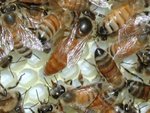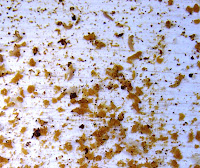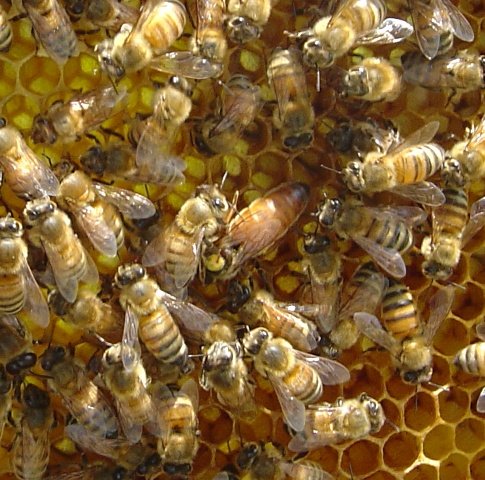Well it is already October and the beekeeping season for 2010 is over.
Left: Honey on the hives in July Right: Same colony at the end of August
And I for one am glad to see it go.
A very early spring brought a very early end to the honey flow, which lengthened the amount of time that there was a lack of nectar and pollen this summer. It does not make a beekeeper happy to see his large, ready to collect hives, sitting with nothing to do.
Our nectar flow here on Cape Cod starts towards the end of June and ends the first week of August.
This year however it started two to three weeks early, and ended two to three weeks early. This resulted in a longer period of time between the spring and fall flows, (almost two months).
Left: A colony started in spring never moved up into the upper hive body. This colony has not produced enough stores to survive the winter.
This combined with late and poor goldenrod nectar flow resulted in starvation conditions for our hives. Hives with 50 to 60 pounds of honey on the hives in July were starving by the end of August.
Of course I am partly to blame for this. We had such good success building up colonies in the spring that there were many more mouths to feed when the nectar flow stopped early.
We have been feeding our hives sugar syrup and pollen substitute since the third week in August. Although the bees are doing well now, and there are plenty of stores in the hives because of the feedings, the additional sugar syrup and the length of time of the feeding has created other problems. namely, a large increase in the small hive beetle population in the hives. I haven't even mentioned the Varroa Mites!
Right: Small hive beetle larva crawling out of the hives onto the bottom boards. The feeding of sugar syrup for such an extended period caused an explosion in small hive beetle. Varroa Mites can be seen on the bottom board as well.
Additionally our five new colonies never moved up into the upper hive bodies. Frames and new foundation were never drawn out or filled with stores for winter. This forced us to combine these weak colonies in order to ensure their survival. The queens of the weaker colonies were killed and their colonies were combined with other weak colonies.
Left: Colony being prepaired for winter. Crisco oil and sugar patty to fight Tracheal Mites, Pollen patty to provide polen when none is being collected, Menthal oil towel to fight Tracheal Mites, Small hive beetle trap, Apastan strips to fight Varroa Mites. Sugar syrup is being fed with a division board feeder in a different hive body.
So, now that the hives are well fed, and in good shape to survive the cold, damp, cape cod winter, it is time to reflect on this past beekeeping season.
Hmmm… What would I, could I, have done different…… right now I just don’t know!
But I will have plenty of time to think about it over the next few months.




















































